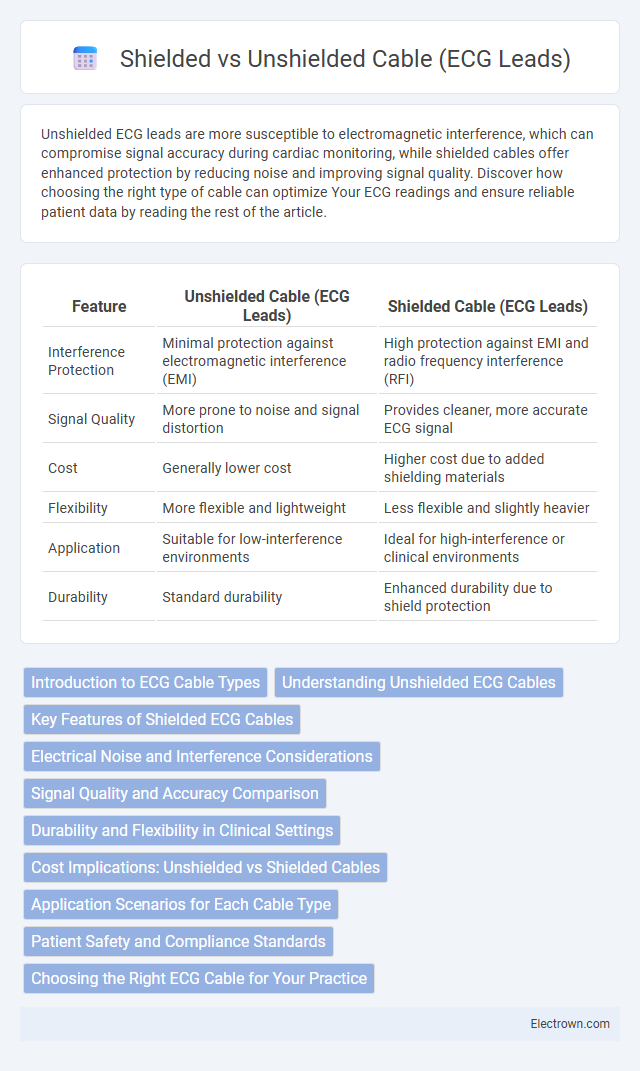Unshielded ECG leads are more susceptible to electromagnetic interference, which can compromise signal accuracy during cardiac monitoring, while shielded cables offer enhanced protection by reducing noise and improving signal quality. Discover how choosing the right type of cable can optimize Your ECG readings and ensure reliable patient data by reading the rest of the article.
Table of Comparison
| Feature | Unshielded Cable (ECG Leads) | Shielded Cable (ECG Leads) |
|---|---|---|
| Interference Protection | Minimal protection against electromagnetic interference (EMI) | High protection against EMI and radio frequency interference (RFI) |
| Signal Quality | More prone to noise and signal distortion | Provides cleaner, more accurate ECG signal |
| Cost | Generally lower cost | Higher cost due to added shielding materials |
| Flexibility | More flexible and lightweight | Less flexible and slightly heavier |
| Application | Suitable for low-interference environments | Ideal for high-interference or clinical environments |
| Durability | Standard durability | Enhanced durability due to shield protection |
Introduction to ECG Cable Types
ECG leads utilize either unshielded or shielded cables to transmit bioelectrical signals from the body to monitoring devices, impacting signal quality and interference resistance. Unshielded cables are typically more flexible and cost-effective but may be susceptible to electromagnetic interference, potentially compromising data accuracy. Shielded cables incorporate a conductive layer that reduces noise and external interference, enhancing signal fidelity, especially in environments with high electrical activity.
Understanding Unshielded ECG Cables
Unshielded ECG cables lack protective layers against electromagnetic interference, making them more susceptible to noise and signal distortion during cardiac monitoring. These cables are typically lighter and more flexible, offering ease of use in clinical settings where minimal interference is expected. You should consider unshielded ECG cables primarily in controlled environments to maintain accurate heart signal acquisition.
Key Features of Shielded ECG Cables
Shielded ECG cables feature a protective metallic layer that reduces electromagnetic interference, ensuring accurate and reliable cardiac signal transmission. The shielding enhances signal integrity by minimizing noise from ambient electrical sources, which is crucial for precise diagnostics. You benefit from improved performance and clearer data acquisition during ECG monitoring, especially in electronically noisy environments.
Electrical Noise and Interference Considerations
Shielded ECG leads significantly reduce electrical noise and interference by creating a protective barrier against electromagnetic fields, ensuring clearer signal transmission. Unshielded cables are more susceptible to picking up ambient electromagnetic interference, which can compromise the accuracy of ECG readings. Choosing shielded cables enhances your device's performance by providing more reliable and noise-free cardiac monitoring in electrically noisy environments.
Signal Quality and Accuracy Comparison
Shielded ECG leads provide superior signal quality and accuracy by minimizing electromagnetic interference and reducing noise, resulting in clearer, more reliable cardiac readings. Unshielded cables are more susceptible to external electrical disturbances, which can lead to distorted signals and less precise diagnostic data. Your choice of shielded cables ensures enhanced accuracy for critical ECG monitoring and analysis.
Durability and Flexibility in Clinical Settings
Shielded ECG leads offer enhanced durability by protecting internal wires from electromagnetic interference, reducing signal noise and extending lead lifespan in busy clinical environments. Unshielded cables provide superior flexibility, allowing easier maneuverability around patients and equipment, which is crucial for quick adjustments during examinations. You should choose shielded leads for environments prone to electrical disturbances and unshielded leads when flexibility and patient comfort are prioritized.
Cost Implications: Unshielded vs Shielded Cables
Unshielded ECG leads typically cost less due to simpler manufacturing processes and fewer materials, making them a budget-friendly choice for routine clinical use. Shielded cables, however, incur higher expenses because of added layers designed to reduce electromagnetic interference and improve signal quality, which is critical in environments with significant electrical noise. Your decision should balance cost with the need for reliable, interference-free readings to ensure accurate cardiac monitoring.
Application Scenarios for Each Cable Type
Unshielded ECG lead cables are ideal for low-interference environments such as clinical settings and home monitoring, where electromagnetic noise is minimal. Shielded cables excel in high-interference areas like intensive care units and emergency rooms, offering superior protection against electromagnetic and radio frequency interference to ensure accurate signal transmission. Selecting the appropriate cable type depends on the specific environment's interference levels and the need for signal integrity in patient monitoring.
Patient Safety and Compliance Standards
Unshielded ECG leads increase susceptibility to electromagnetic interference, potentially compromising patient safety and accurate cardiac monitoring. Shielded cables meet strict compliance standards such as IEC 60601-1 by reducing noise and ensuring reliable signal transmission for critical diagnostic accuracy. Selecting shielded leads enhances Your device's adherence to safety regulations and reduces risks associated with faulty ECG readings.
Choosing the Right ECG Cable for Your Practice
Selecting the right ECG cable for your practice depends on factors such as signal clarity, interference, and patient safety. Shielded cables reduce electromagnetic interference and improve signal quality in electrically noisy environments, while unshielded cables offer greater flexibility and are often sufficient for standard clinical settings. Your choice should balance the need for accurate ECG readings with practical considerations like durability and cost-effectiveness.
Unshielded vs Shielded Cable (ECG Leads) Infographic

 electrown.com
electrown.com